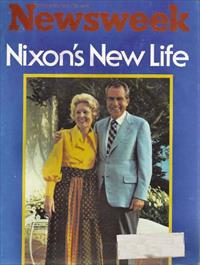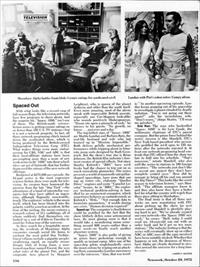Press
1975 Smash
Newsweek is a weekly US news magazine based, running since 1933. In addition to the standard US edition, there was a separate "international" edition with different covers and more European content.


by Harry F. Waters
Newsweek, October 20, 1975, page 116
With what looks like a record crop of fall-season flops, the television networks have few programs to cheer about. And the surprise hit, Space: 1999, isn't one of them. The British-made science-fiction series is getting cosmic ratings on no fewer than 155 U.S. TV stations- but it is not a network property. In fact, all three network programming chiefs turned down the syndicated show, which is being produced by the British-owned Independent Television Corp. (ITC). What makes things even more embarrassing for CBS, NBC and ABC is that their local-affiliate stations have been pre-empting more than a score of network series to fit 1999 into their schedules- an act of fratricide that has further depressed the ratings of the new network offerings.
Budgeted at $275,000 per episode, the 24-part episode series is the most expensive science-fiction show ever made for television. Its creators have borrowed the premise from the late Star Trek- the adventures of a band of interstellar voyagers- but they have added an ingenious, although flagrantly unscientific touch. The explorers' vehicle is the moon itself, which has been blasted into the galaxy void by a nuclear accident. At the time of the mishap, the moon contains a research colony of 311 earthlings, all of whom suddenly find themselves embarked on a sort of if-this-is-Tuesday-it-must-be-Triton tour of the universe.
As they search for a hospitable mooring, the residents of Moonbase Alpha encounter enough weird life forms to enchant the most jaded Star Trekkie. Guest villains include a gigantic people-swallowing squid, an equally misanthropic blob of living foam, a man-turned-machine named Gwent, the sexy robot ruler of the planet Piri, and the enigmatic Arra (played by Margaret Leighton), who is queen of the planet Astheria and older than the earth itself. Even more amazing, most of the aliens speak with impeccable British accents, especially one Cro-Magnon look-alike who sounds positively Shakespearean. "Doom sits upon a pinnacle of rock," he intones to his guests. "No growth, no future... just ever and a day."
The top-billed stars of Space: 1999 are Martin Landau and Barbara Bain, the real-life husband and wife who last teamed up in Mission Impossible. Both deliver gelidly mechanical performances while tripping about in futuristic jump suits designed by Rudi Gernreich. But the show's true star is Brian Johnson, the British film industry's foremost creator of special effects. Not since Stanley Kubrick's 2001 have sci-fi freaks had the chance to trip out on so much surrealistic gimmickry. The series presents a world of mammoth caterpillar-shaped spaceships, laser guns that can zap an entire city, elaborate "Queller Drive" engines and eerie "Camelot Locator" beams [Camelot locator beam was a bizarre misprint in ITC publicity for "commlock locator beam"]. As in 2001, the explorers' technical problems-solving is handled by an omniscient computer, which sometimes behaves as cantankerously as Kubrick's "HAL." " Not enough data to formulate parameters," it scolds during one crisis. "Human decision required!"
SPEED-UP: The computer's churlishness could be justified by the fact that the show blithely defies some astronomical laws. Its most glaring error is that it would take a meandering moon something around 800 years- rather than a mere week- to finally reach another planetary system.
Space:1999 is also guilty of giving its actors lines pedestrian enough to qualify as instant camp. After one of his spaceship pilots singlehandedly saves the moon colony by wiping out an attacking fleet, commander Landau announces over the intercom: "Alan, that was terrific." In another upcoming episode, Landau keeps popping out of his spaceship to investigate a planet clouded by deadly radiation. "You're not going out there again?" asks his incredulous wife. "Don't worry," chirps Martin. "I'll wear my galoshes."
END RUN: The man who bankrolled Space:1999 is Sir Lew Grade, the millionaire chairman of ITC's parent company. But the prime force behind the series' success is Abe Mandell, ITC's New York-based president who personally peddled the sci-fi opus to 155 stations after the networks rejected it. At least one network programing head contents that ITC offered him the show too late to fold into his schedule. "That's nonsense," retorts Mandell, who also sold the series in 100 foreign countries. "The networks just don't like to accept any project they don't have complete control over." How did he manage to bring off his end run around the Big Three? "This looks like the worst season in television history," says Mandell. "The affiliate managers know it, and they also know they have a better feel for what the country will watch than three guys in Manhattan."
The final irony is that all three networks are now negotiating with ITC about picking up the show for next season- and Mandell is gleefully playing hard to get. "We've already created our own network- the Space:1999 network," he crows. "Hell, today I could send my 14-year-old son out with an order book and he'd get us ten more stations." The industry betting is that the series will eventually show up on either NBC or ABC once all the egos involved have been suitably strokes. Whether that happens or not, the denizens of Moonbase Alpha are clearly destined to ricochet around the universe for a long time to come.
black and white photos:
Space: 1999 copyright ITV Studios Global Entertainment
Thanks to Robert Ruiz